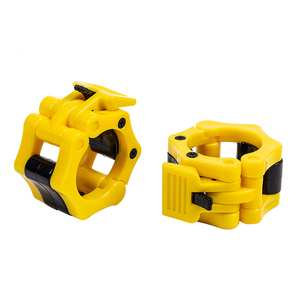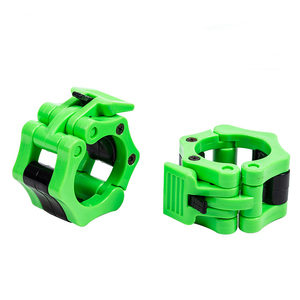(16604 products available)



















































































































































































































There are various types of Quick Release Clamp Collars in the market. Some of the most popular ones include:
Split Collar
Split collar is a common quick release collar type. It has a split or opening that enables users to easily install or uninstall it. This collar provides users with convenience when using the quick release mechanism. The collar can be adjusted easily on a shaft for different applications. It offers secure positioning and does not damage the shaft. This collar is popular in several industries that require frequent adjustments and repositioning.
Set Screw Collar
Set screw collar is another popular collar that features a set screw. This screw is tightened against the shaft to secure the collar in place. These quick release clamp collars provide a firm hold and are simple to install and remove. However, the presence of a set screw may damage the shaft. This collar is widely used in applications that do not require frequent adjustments or repositioning.
Lever-Activated Collar
This collar is designed to be adjusted easily with a lever. This makes it a great option for users who need to make quick adjustments. The lever is easy to operate, allowing users to adjust the collar's tightness with little effort. This collar is perfect for applications where frequent adjustments are required. It also offers convenience and time-saving benefits.
Hinged Collar
Hinged collar is designed with a hinged mechanism. This collar can be opened and closed easily, making it simple to install and remove. It offers convenience and time-saving benefits. This collar is commonly used in applications where frequent removal and reinstallation are required.
Quick Release Pin Collar
This collar is designed with a quick-release pin mechanism. It allows users to make fast adjustments. The quick-release pin provides convenience. This collar is widely used in applications that require frequent adjustments.
Quick-release clamp collars are versatile tools used in various applications that demand rapid adjustments and firm grip. Here are some common usage scenarios:
Mechanical Systems
Quick-release clamp collars are essential for swiftly fastening or modifying components in machinery. These collars simplify maintenance and adjustments in assembly lines and conveyor systems.
Automotive Industry
These collars allow for rapid modifications and secure fittings in automotive applications during motorsport events. This feature is particularly useful when making frequent changes to vehicle setups, such as altering axle lengths or modifying suspension components, where time efficiency is crucial.
Medical Equipment
These collars provide quick adjustments and secure fittings in various medical apparatus, including adjustable IV poles and movable patient beds. Quick-release clamp collars enable seamless modifications and stability in these essential tools.
Sports and Fitness
These collars are utilized in sports and fitness equipment, such as adjustable benches and barbells. They allow for rapid changes in equipment settings, facilitating smooth transitions between exercises and ensuring the safety of users by maintaining a secure hold.
Photography and Videography
These collars provide quick adjustments and secure fittings in various medical apparatus, including adjustable IV poles and movable patient beds. Quick-release clamp collars enable seamless modifications and stability in these essential tools.
Musical Instruments
These collars provide quick adjustments and secure fittings in various musical apparatus, including adjustable IV poles and movable patient beds. Quick-release clamp collars enable seamless modifications and stability in these essential tools.
Knowing which quick-release clamp collar to choose can be challenging, especially when many options are available. Here are some things to consider when selecting a collar.
Material
It is essential to select a collar made of durable and long-lasting material such as stainless steel, aluminum, or plastic. Remember that stainless steel is more robust than aluminum and plastic. Also, remember that plastic collars are more lightweight than metal collars.
Compatibility
It is necessary to check the compatibility of the collar with the specific equipment or pipe. Ensure it has the right size and diameter to fit perfectly on the device or pipe to provide a secure and stable hold.
Grip Strength
Select a collar with a strong grip for the intended use. Remember that some applications require more strength than others. The good thing about quick-release clamp collars is that they provide convenience and have sufficient gripping power for most applications.
Adjustability
Choose a quick-release collar that is adjustable to allow customization of the grip to the required level. This feature is especially useful in applications where the required grip may vary. Remember that an adjustable collar can save one time and effort when making minor adjustments.
Ease of Use
It is advisable to select a collar designed to be easily installed and removed, especially when frequently done. Look for collars with ergonomic design features, such as a well-designed release mechanism.
Application Requirements
When choosing a quick-release collar, consider the specific needs of the application. Some situations require features like corrosion resistance, which can be solved by using stainless steel or plastic.
Price
Compare prices from different vendors and select one that is within the budget. However, ensure that the collar selected is of good quality and has the required features.
Quick-release clamp collars come in various designs and feature sets tailored to different applications and requirements. Here are some of them alongside their functions:
Function
The primary function of a quick-release clamp collar is to provide a fast, secure method of clamping that allows for easy adjustments and rapid removals.
Features
These collars are typically built to support high loads while offering durability and resistance to wear. Some feature integrated locking mechanisms to prevent accidental openings.
Design
These collars are fabricated from diverse materials such as stainless steel, plastic, and aluminum, and their design may incorporate ergonomic handles for improved grip during the release process.
Q1: What materials are typically used for quick-release clamp collars?
A1: Quick-release clamp collars are commonly made of metal materials like stainless steel, steel, or aluminum. Some clamp collars may be made of high-strength plastics or composites for specific lightweight applications.
Q2: Are quick-release clamp collars suitable for heavy-duty applications?
A2: Quick-release clamp collars can be suitable for heavy-duty applications, depending on their design, materials, and construction quality. It's essential to choose a collar rated for the required load and operating conditions.
Q3: Can quick-release clamp collars be used in outdoor or harsh environments?
A3: Quick-release clamp collars can be used in outdoor or harsh environments if they are made of corrosion-resistant materials, such as stainless steel, or have appropriate protective coatings. It is important to consider the environmental conditions when selecting a collar to ensure durability and long-term performance.
Q4: How do I know if a quick-release clamp collar will fit my application?
A4: To determine if a quick-release clamp collar will fit a specific application, measure the diameter of the shaft or pipe to ensure the collar's size matches. Check the material and load capacity to ensure it suits the application requirements.
Q5: Can quick-release clamp collars be adjusted or resized?
A5: Quick-release clamp collars can be adjusted but not resized. The collar can be adjusted to fit different sizes using its quick-release mechanism. However, once a fixed diameter is set, it cannot be resized to fit a different diameter range without replacement.
The web search volume for the keyword "quick release clamp collar" has shown a stable trend over the past year, with an average monthly web search volume of 210. Despite no significant changes in the three-month and one-year comparisons, monthly web searches have fluctuated between 140 and 260.
Analyzing the monthly data, we notice a pattern where web search volumes peak at 260 in February 2024 and reach their lowest at 140 in January 2024. This suggests a slight seasonal variation, with peaks typically in the early months of the year and a dip at the beginning. The months of May, July, and October 2024 each recorded 210 web searches, indicating a consistent interest during these periods.
The stability in web search volume, despite minor fluctuations, implies a steady demand for this tool in the hardware sector. The lack of significant growth or decline over the year could suggest market maturity or saturation, where the tool has established a consistent user base without substantial increases or losses in interest. This consistent demand underscores the necessity of the product in its market segment, reflecting reliable usage patterns among consumers.